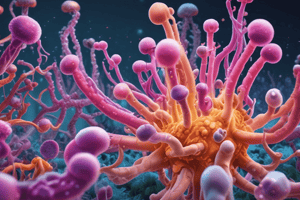Podcast
Questions and Answers
Which anaerobic media is specifically selective for Bacteroides Fragilis?
Which anaerobic media is specifically selective for Bacteroides Fragilis?
What characteristic of Clostridium tetani is significant in its identification?
What characteristic of Clostridium tetani is significant in its identification?
Which of the following anaerobes is associated with Lemierre's syndrome?
Which of the following anaerobes is associated with Lemierre's syndrome?
Which antibiotic is Fusobacterium resistant to?
Which antibiotic is Fusobacterium resistant to?
Signup and view all the answers
What type of infections is Prevotella melaninogenica primarily associated with?
What type of infections is Prevotella melaninogenica primarily associated with?
Signup and view all the answers
Which anaerobic bacterium is characterized by producing a 'horse manure' odor?
Which anaerobic bacterium is characterized by producing a 'horse manure' odor?
Signup and view all the answers
Which non-spore-forming Gram-positive bacilli is commonly linked to acne?
Which non-spore-forming Gram-positive bacilli is commonly linked to acne?
Signup and view all the answers
What type of morphology does Fusobacterium nucleatum exhibit?
What type of morphology does Fusobacterium nucleatum exhibit?
Signup and view all the answers
Which of the following Gram-positive cocci is considered highly virulent?
Which of the following Gram-positive cocci is considered highly virulent?
Signup and view all the answers
Which selective antibiotic is Bacteroides fragilis resistant to?
Which selective antibiotic is Bacteroides fragilis resistant to?
Signup and view all the answers
What growth requirement is essential for anaerobic media?
What growth requirement is essential for anaerobic media?
Signup and view all the answers
Which organism is the most commonly isolated anaerobe associated with abdominal infections?
Which organism is the most commonly isolated anaerobe associated with abdominal infections?
Signup and view all the answers
Which of the following characteristics best describes Clostridium botulinum?
Which of the following characteristics best describes Clostridium botulinum?
Signup and view all the answers
What type of infection is primarily linked to Prevotella intermedia?
What type of infection is primarily linked to Prevotella intermedia?
Signup and view all the answers
Which selective antibiotic is Fusobacterium most commonly resistant to?
Which selective antibiotic is Fusobacterium most commonly resistant to?
Signup and view all the answers
What distinctive morphology is associated with Fusobacterium necrophorum?
What distinctive morphology is associated with Fusobacterium necrophorum?
Signup and view all the answers
Which spore-forming Gram-positive bacillus is associated with food poisoning?
Which spore-forming Gram-positive bacillus is associated with food poisoning?
Signup and view all the answers
Which organism is known for producing a 'musty' odor and linked to soft tissue infections?
Which organism is known for producing a 'musty' odor and linked to soft tissue infections?
Signup and view all the answers
What is the primary reason anaerobes are typically used in specific growth media?
What is the primary reason anaerobes are typically used in specific growth media?
Signup and view all the answers
Which organism is most commonly associated with intra-abdominal infections due to its prevalence in the GI tract?
Which organism is most commonly associated with intra-abdominal infections due to its prevalence in the GI tract?
Signup and view all the answers
What type of conditions is Clostridium botulinum primarily associated with?
What type of conditions is Clostridium botulinum primarily associated with?
Signup and view all the answers
Which anaerobic medium is used to select for Gram-negative anaerobes?
Which anaerobic medium is used to select for Gram-negative anaerobes?
Signup and view all the answers
What is the distinct morphology of Fusobacterium nucleatum?
What is the distinct morphology of Fusobacterium nucleatum?
Signup and view all the answers
Which of the following is true regarding the susceptibility of Fusobacterium species?
Which of the following is true regarding the susceptibility of Fusobacterium species?
Signup and view all the answers
Which organism is linked to the formation of sulfur granules in pus?
Which organism is linked to the formation of sulfur granules in pus?
Signup and view all the answers
What type of infection is associated with Porphyromonas gingivalis?
What type of infection is associated with Porphyromonas gingivalis?
Signup and view all the answers
What is the primary role of Vitamin K and Hemin in anaerobic media?
What is the primary role of Vitamin K and Hemin in anaerobic media?
Signup and view all the answers
Which characteristic differentiates Clostridium perfringens from other spore-forming Gram-positive bacilli?
Which characteristic differentiates Clostridium perfringens from other spore-forming Gram-positive bacilli?
Signup and view all the answers
How does Peptostreptococcus anaerobius primarily contribute to infections?
How does Peptostreptococcus anaerobius primarily contribute to infections?
Signup and view all the answers
What is a common misconception about Fusobacterium nucleatum?
What is a common misconception about Fusobacterium nucleatum?
Signup and view all the answers
What distinguishes Porphyromonas gingivalis from other pigmented Gram-negative bacilli?
What distinguishes Porphyromonas gingivalis from other pigmented Gram-negative bacilli?
Signup and view all the answers
Which factor is critical for distinguishing between Clostridium species?
Which factor is critical for distinguishing between Clostridium species?
Signup and view all the answers
What role does Kanamycin-Vancomycin media serve in the identification of anaerobes?
What role does Kanamycin-Vancomycin media serve in the identification of anaerobes?
Signup and view all the answers
Which organism's presence is indicated by a 'butterscotch' odor?
Which organism's presence is indicated by a 'butterscotch' odor?
Signup and view all the answers
Which type of infections are predominantly associated with Cutibacterium acnes?
Which type of infections are predominantly associated with Cutibacterium acnes?
Signup and view all the answers
Why is Bacteroides fragilis significant in clinical microbiology?
Why is Bacteroides fragilis significant in clinical microbiology?
Signup and view all the answers
Study Notes
Anaerobes
- Anaerobes lack oxidative enzymes like superoxide dismutase and catalase.
- Intra-abdominal abscesses are a common type of endogenous infection caused by anaerobes.
- Anaerobic media require vitamin K and hemin.
- Thioglycollate broth is a common medium for growing anaerobes.
- Phenylethyl alcohol inhibits Enterobacteriaceae and is selective for Gram-positive and Gram-negative anaerobes.
- Kanamycin-vancomycin is selective for Gram-negative anaerobes.
- Bile-esculin is selective for Bacteroides fragilis.
- Egg yolk differentiates anaerobes based on fat breakdown abilities.
Selective Antibiotic Disks
- Bacteroides fragilis is resistant to kanamycin, colistin, and vancomycin.
- Fusobacterium is susceptible to kanamycin and colistin but resistant to vancomycin.
- Clostridium is susceptible to vancomycin but resistant to colistin.
Gram-Negative Bacilli
- Bacteroides fragilis is the most commonly isolated anaerobe, found in the GI tract, and frequently associated with abdominal infections.
- Fusobacterium nucleatum has a pointed, spindle-shaped morphology and is associated with biofilm infections.
- Fusobacterium necrophorum is pleomorphic and linked to Lemierre's syndrome and Vincent's angina.
Pigmented Gram-Negative Bacilli
- Prevotella melaninogenica causes respiratory and periodontal infections.
- Prevotella intermedia is associated with gingivitis and oropharyngeal infections.
- Porphyromonas asaccharolyticus is linked to genital infections.
- Porphyromonas gingivalis causes gingivitis and chronic periodontitis (but displays no red fluorescence).
Spore-Forming Gram-Positive Bacilli
- Clostridium perfringens shows double beta-hemolysis and is associated with gas gangrene and food poisoning.
- Clostridium tetani has drumstick-shaped spores and causes tetanus (muscle spasms).
- Clostridium botulinum causes botulism (nervous system attack).
- Clostridiodes difficile has a "horse manure" odor and causes antibiotic-associated diarrhea/pseudomembranous colitis.
- Clostridium septicum is a cause of gas gangrene in malignancies.
Non-Spore-Forming Gram-Positive Bacilli
- Actinomyces israelii is a branching rod associated with actinomycosis (sulfur granules).
- Cutibacterium (formerly Propionibacterium acnes) is linked to acne and medical device infections.
- Lactobacillus is rarely pathogenic but can cause endocarditis.
- Bifidobacterium has a "dog bone" shape and is used as a probiotic.
Gram-Positive Cocci
- Finegoldia magna is a highly virulent species associated with skin, bone, and joint infections.
- Peptostreptococcus anaerobius causes abdominal, pelvic, and brain abscesses.
- Peptoniphilus asaccharolyticus forms yellow colonies with a musty odor and is linked to soft tissue infections.
- Microaerophilic Streptococcus has a butterscotch odor, is beta-hemolytic, and is associated with endocarditis, dental, and respiratory infections.
Gram-Negative Cocci
- Veillonella is highly oxygen-sensitive and requires a glove box for growth.
Studying That Suits You
Use AI to generate personalized quizzes and flashcards to suit your learning preferences.
Description
Explore the fascinating world of anaerobes with this quiz covering their growth requirements, common infections, and resistance patterns to selective antibiotics. Test your knowledge on key species like Bacteroides fragilis and their implications in clinical microbiology.




